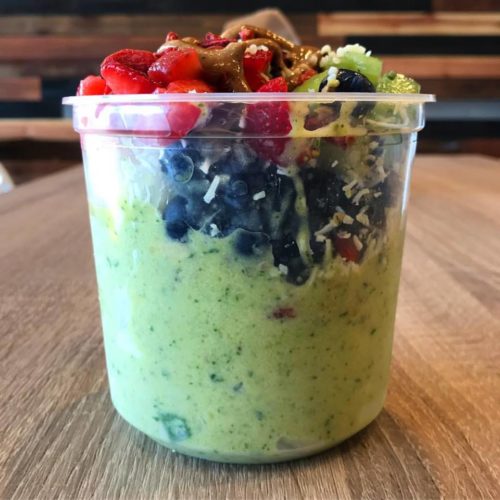
What is soursop?
Soursop is a fruit that is indigenous to tropical areas around the world including South America and southeast Asia. It’s scientific name is annona muricata and is also known as graviola, guanábana, guyabano, corossol and thu-rian-khack.
One of the most common questions is, “What does it taste like?” If you’ve never had soursop before, you’ll notice that it has a creamy banana-like texture and tastes like a combination of apple and strawberry with a touch of citrus.
Similar Fruits
From the outside, soursop looks related to other spiky oval-shaped fruits like durian and jackfruit. However, their similarities end at their prickly exterior. While soursop has a whitish interior, durian and jackfruit are more yellow-orange. Durian is an exotic fruit requiring an acquired taste of incongruent savory, sweet and creamy flavors. The potent smell of durian is widely known—likened to turpentine, rotting meat and gym socks…no joke. Jackfruit is the largest of the three and has a sweet pineapple and banana flavor. Its meaty texture has made it a popular meat substitute.

A fruit that is closely related to soursop is sweetsop (a.k.a. sugar apple, sugar pineapple, or custard apple). They are both packed with health benefits and have similar creamy flavors and textures, but sweetsop smaller in size and isn’t spiny.

Health Benefits
Soursop is known to contain many healthy properties. Here’s a quick list of the scientifically-proven health benefits it provides.
- rich in minerals – abundant in iron, calcium, sodium, copper, and magnesium
- high in antioxidants – prevents damage done by cellular oxidants to improve eye health
- anti-inflammatory and antimicrobial properties – can relieve pain, heal wounds, treat infections, reduce stress, improve skin complexion, provide respiratory relief and reduce arthritic swelling
- possible cancer-killing properties – studies have shown it can reduce tumor size and prevent the formation of cancer cells
Note: Clinical trials may be insufficient. Consult a doctor before taking this fruit (or any other substance) to treat any type of ailment or disease.
Where can I get soursop?
Soursop is available in many different forms including fresh fruits, juices, teas, and supplements. You can find fresh soursop in select specialty food markets that have exotic produce. They are also likely to have soursop or guyabano juice. It is also available in supplement form (usually tablets or powder) in many health food stores and is commonly labeled as graviola.If you don’t have any international food markets nearby, you can easily order any of these online: guyabano juice, tea leaves, graviola capsules and powder. However, if you’re looking to taste soursop in a variety of foods, here are a few notable spots where you can try them.
Miami, FL (nationwide locations): Vitality Bowls
—graviola bowl—

San Francisco Bay Area, CA (San Mateo): Snacks
—guanabana (soursop) ice cream—

San Diego, CA: Everbowl
—graviola bowl—
How do I eat soursop? What does it go with?
If you’re simply looking to incorporate soursop into your diet, there are several ways to do this. The easiest way is to take a supplement. Or, you can drink it as a juice or a tea. You can also add it in powder form to your oatmeal, smoothies, and fruit bowls. If you opt for this form, simply make sure to add it gradually (i.e. one tablespoon at a time) to suit your taste. Cheers to better health!












